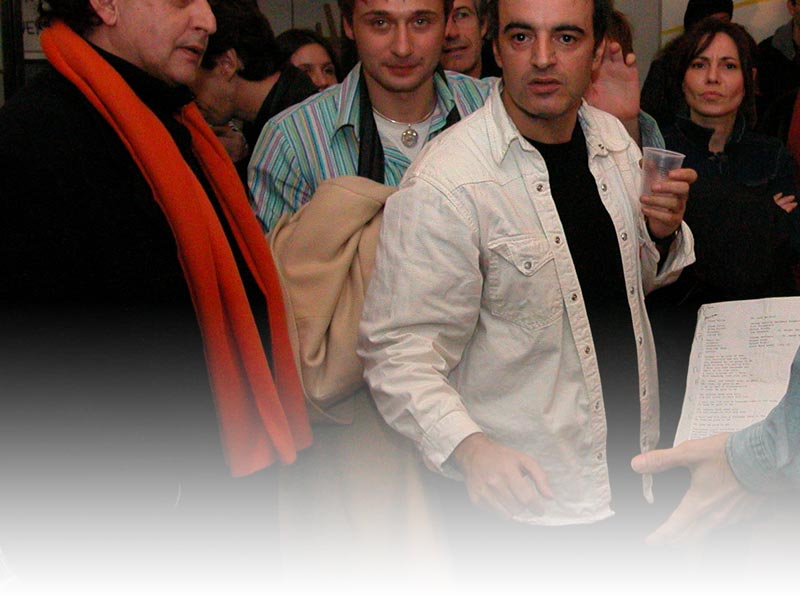
Benton Bainbridge
This posting is for review purposes only. Thanks to Film Scouts.
by Crissa-Jean Chappell
It lasts forty minutes (that's four times the national average for love-making) this smoldery, abstract blaze of color, pulsating in sync with a two-syllable tune‹hypnotic, electro interludes like a heart beating to an oceanic tempo. One might stare at it and find all sorts of naughty undertones in the manner of a Rorschach blot. "Blind Heat" is an example of deflective media, a video designed to turn a viewer away from the television or, as its creator, Benton Bainbridge, says, "a tool for igniting passion, a means of invigorating conversation because you're no longer spending large chunks of an evening letting TV people talk for you."
On the phone, his boomy voice lofts into questions. "Can you hear me?" he says with a foghorn-like blast. Benton-C Bainbridge has performed, screened, streamed, broadcast and installed video worldwide over the wires and airwaves in museums, galleries, clubs, colleges and festivals including the Whitney Museum of American Art (NYC), the Museum of Modern Art (NYC), STEIM (Amsterdam), Metafort d'Aubervilliers (Paris), and Miami Light Project. His latest video stems from Blind Eye media, a label releasing videos designed to distort the regular use of television, or in their terms, "reverse media logic," deflecting instead of attracting your eye towards the screen. This doesn't mean that the work that is meant to be ignored. According to Benton, the audience's attention is simply "re-directed." One definition of Blind Eye media reversal compares the videos to a collision of waves in a bathtub neutralizing into still waters or silence in the case of sound.
The project originated in the mid-1990s, when head honcho Willy Mal proposed marketing videos called "look away TV" as an alternative to the "emotion-altering drug." Unlike a video "eye-raping," along the lines of Stan Brackage (an experimental film pioneer who assaults the senses with a blizzard of doodles and scratches on strips of celluloid), the Blind Eye videos, says Willy Mal, "catapult you out of the pleasureplex of media's warm and sweet bath into the cool air high above the glimmering lights. At least for the length of the tape."
Exoptic Fields, the first video in the series, resembles a bottle of aspirin. Benton calls it "a cure for coach potatoes, excessive Internet surfers, and other people whose gaze is too strongly glued to the screen." Benton's approach differs from the other Blind Eye denizens because he intends his video to "color" or create a different mood for a room as a more positive application for television, that "ugly black box" that sits inside your entertainment center. "If, in fact, watching too much television de-sensitizes you," he says, "there's a possibility to negate that quality and open up the other senses."
No matter if viewers compare "Blind Heat" to those kitchy VHS tapes that turn your TV into a flickering reproduction of a fireplace. "In a way, the goal is a little bit similar," he says. "You don't put on the video fireplace to watch it raptly with attention for forty-five minutesŠand if you have your VCR on auto-repeat, even longer," he chuckles. "But there are two difference. The first, like all the Exoptic Blind Eye media projects, there are a series of rules applied to it to direct your eyes away from the screen. And the second, a video fireplace is more of a neutral mood, meaning that this tape, Blind Heat, isn't a warm, yellow light. It's a red light, which tends to be a more passionate color. Fires, in themselves, induce a sense of comfort, warmth, securityŠdepending on your background, a sense of family. Blind Heat is specifically about passion."
He claims that a couple could pop it on in place of an X-rated tape. The thought rips some giggles from him. He gains his syntactical footing and says, "The point is not necessarily lustful or erotic passion. It's more about trying to re-capture a sense of passion from what I consider a very dispassionate appliance. How people want to use it is up to them." He doesn't know if the video would lose its effectiveness if played, ala Andy Warhol, as digital background fodder for a club. "Whatever an artist intends doesn't ultimately matter in the creation of a work. It's really how it's received. That's my own personal belief."
Benton, a self-described "cynical optimist," says, "I can't think of a more backward way to watch television. You know, TVs have gotten progressively uglier over history. I'm looking at the TV in this room. Well, okay. It's got a black frame. I can dig that. But it's an ugly piece of plastic with, like, a logo on the front. So that you're constantly looking at a logo when you're viewing this 'window onto reality.' And it's something that doesn't receive. It's like an ugly eye on a room.
"What might start happening," says Benton, "is the same kind of thing that occurred with music. It wasn't normal before to have radios on playing music all the time. It's become more common since the late sixties to decorate a room with music and have a sonic space. Once we have the equivalent of video jukeboxes in every home (his current endeavor, called Triggers)Šthen I think it will be more common for us to say, 'I want something on that functions more like a video painting.' To me, electricity is not something that's unnatural or cold. If anything, electricity, along with every other tool, is just an extension of human ability. Our central nervous system is an electrical device. In a way, it can seem unnatural. Unless you consider human beings to be unnatural. And I know some people who do."
Copyright 1994-2001 Film Scouts LLC
Created, produced, and published by Film Scouts LLC
Film Scouts® is a registered trademark of Film Scouts LLC
All rights reserved.